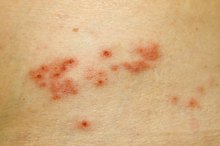What Are the Treatments for Positive HPV & ASCUS?
HPV is the abbreviation for the human papillomavirus. This refers to a group of more than 100 different viruses. Studies by the Centers for Disease Control and Prevention suggest that approximately 20 million Americans are currently infected with HPV, with this number rising as 6.2 million people are diagnosed with the virus annually. It is estimated that up to 50 percent of all sexually active people will be infected with HPV during the course of their lives. While most forms of HPV are harmless, certain types of the virus can cause ASCUS, which requires treatment.
ASCUS
ASCUS, short for atypical squamous cells of unknown significance, refers to a result on a pap smear. Pap smears are an annual test that all sexually active women should have. The test involves scraping the cells of the cervix to look for abnormal cell changes, which can eventually lead to cervical cancer. When ASCUS is detected on a pap smear, some doctors will perform another pap test in six months. Other doctors will test for a high-risk strain of HPV. HPV types 16, 18, 6, and 11 are considered to be high-risk strains that can eventually cause cervical cancers or cancers of the vulva or vagina.
ASCUS and Positive HPV
What Are the Treatments for Positive HPV & ASCUS?
Learn More
If ASCUS is detected and an HPV test is performed to test for high-risk HPV, additional testing is required if the HPV test is positive. With both a positive HPV result and ASCUS, doctors will typically perform a colposcopy. The colposcopy allows the doctor to shine a light within the cervix to magnify it, so the doctor can examine the cervix more closely, along with the vulva and vagina. The doctor typically opens the vagina with a speculum and then applies a vinegar solution to the cervix with a swab. The vinegar makes abnormal cells turn white, so the doctor can examine them.
HPV Treatment
There is currently no treatment for HPV, although it is possible for women between certain ages to be vaccinated for HPV to avoid becoming infected with a dangerous strain of the virus. Once you are infected with HPV, the virus will remain in your body, unless your body eliminates the virus itself. Typically, the virus is harmless and it is not necessary to treat it. However, the presence of the virus in conjunction with ASCUS necessitates the colposcopy because, in this context, there is a strong probability that the virus is causing cell changes in the cervix that could eventually lead to cervical cancer if untreated.
Treating ASCUS
How Men Get Tested for STDs
Learn More
The appropriate treatment for ASCUS is typically to repeat the pap smear within six months because the ASCUS might be caused by an infection or other minor irritation. However, with a positive HPV test, merely repeating the test is not appropriate, because there is a much higher chance that the ASCUS is specifically caused by the HPV as opposed to an unrelated infection. Thus, a colposcopy will be performed. Treatment then depends on the results of the colposcopy. The ASCUS itself is not treated; however, if abnormal cells are discovered during the colposcopy, those abnormal cells may be treated.
Treatment Following a colposcopy
The purpose of the colposcopy is to determine whether the ASCUS actually means there is an abnromal area on the cervix. If the doctor identifies an abnormal area during the procedure, the doctor will scrape cells from the area and perform a biopsy. The biopsy determines whether the abnormal area is precancerous, cancerous or benign. If abnormal cells are identified as cancerous or precancerous, cyrosurgery is typically performed. This involves inserting a metal probe into the cervix to freeze and kill the abnormal cells. Generally, this treatment has no effect on the integrity of the cervix and no effect on fertility. If there are no abnormal cells identified during the colposcopy, or if the cells are benign, generally the only treatment is the pap smear is repeated within a few months.
Related Articles
References






